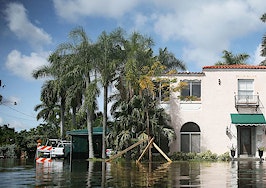A darkly precise report released Friday by 13 federal government agencies concludes that as many as 49.9 million homes along United States shorelines could be threatened by rising sea levels caused by global warming.
Mandated by Congress and released publicly by the Trump administration, the second volume of the fourth National Climate Assessment estimates that homes and businesses valued at approximately $1.4 trillion sit within ⅛ of a mile from a U.S. coast. With 66-percent probability, the 1,656-page report projected that between $66 billion and $106 billion in real estate could sink below sea level by 2050, and between $238 billion and $507 billion by 2100.
“Flooding from rising sea levels and storms is likely to destroy, or make unsuitable for use, billions of dollars of property by the middle of this century, with the Atlantic and Gulf coasts facing greater-than-average risk compared to other regions of the country,” according to authors of the report, which includes scientists from the U.S. Global Change Research Program and the National Oceanic and Atmospheric Administration.
Blunt in its conclusions and more precise in its calculations than in previous iterations, the report estimates that global warming over the next century threatens to whittle away as much as 10 percent of the American economy if significant steps aren’t taken within the next decade.
Overall, The National Climate Assessment predicts some industrial sectors could see losses of hundreds of billions of dollars per year, with the entire economy shrinking 10 percent by 2100. The report follows similar findings from the United Nations’ Intergovernmental Panel on Climate Change, which warned that the planet has about 12 years to reduce global warming below 1.5 degrees celsius to safeguard against flooding, heat waves and drought.
With an uptick in violent storms across the East Coast and a series of historic wildfires along the West Coast, major shifts are needed in rural and urban communities to achieve adequate climate resiliency, the report concludes.
Although many cities have implemented infrastructural improvements to safeguard against climate change, including the installation of seawalls and pumps and the preservation of mangroves and wetlands, many state-level agencies have not gone far enough to reverse the tide of global warming.
“Addressing the full range of future climate change requires substantial changes in organizational practices and procedures, in public- and private-sector institutions, in individual and societal expectations and norms, in capital investment planning, and in laws,” according to the authors. “This involves seeking, legitimizing, and accelerating large changes, rather than attempting to retain today’s conditions as long as possible.”
Beyond challenges to urban infrastructure and utility delivery, the report outlines the human cost of climate change. When temperatures are higher, service delivery of healthcare increases pressure on household spending, and overall quality of life is negatively affected, according to the report.
In rural areas, communities face many of the same issues. Rising temperatures can result in health risks like heat stroke, exhaustion and heart attacks while prolonging pollen and allergy seasons. The report also projected population decline, reduced agricultural productions and the degradation of natural resources like soil and water as well as a higher frequency of multiple, cascading natural disasters.
“Over a four-day period in 2015, the coastal city of Charleston in the Southeast region experienced extreme rainfall, higher sea levels, and high tide flooding,” according to the authors. “These impacts combined to cause dam failures, bridge and road closures, power outages, damages to homes and businesses, and a near shutdown of the local economy.”
Less certain is a response from the Trump administration. Since his election in 2017, Donald Trump has spearheaded the reversal of several Obama-era regulations aimed at reducing the sources of greenhouse gases.
Indeed, according to reports in The Washington Post, officials who produced the report were “frustrated, but not surprised, that the administration chose to release it on the day after Thanksgiving.”









